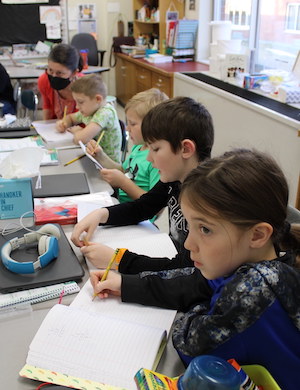On March 18, 2022, teachers from Solvay Union Free School District had the opportunity to observe teachers from Burton Street Elementary School in the Cazenovia (NY) Central School District teach a science module on soil erosion to kindergarten through second-graders.

This Lesson Study—led by Professor Sharon Dotger and Solvay UFSD Assistant Superintendent of Educational Services Jessica Whisher-Hehl G’09, G’16—continues Syracuse University School of Education’s extensive and immersive collaboration with Syracuse-area schools.
Using BOCES Science Kits, Cazenovia teachers Christy Allen (kindergarten), Beth Ann Kempf (first grade), and Julie Kielbasinski encouraged their young students to explore properties of soil; how soil interacts with water, sand, and natural and built environments; and how different interventions can decrease the likelihood of soil erosion.
Solvay teachers closely observed the lessons, including how the Cazenovia teachers presented new information and set up experiments and how students interacted with the materials and each other. This review and reflection is core to the Lesson Study method of professional development, which is derived from the established Japanese teaching and learning continuous improvement model of jugyou kenkyuu.
In Allen’s kindergarten class students discovered how water flows in natural and built environments. The lesson included a hands-on experiment to control the flow of water using various interventions—such a dam—in a diorama, with the goal of protecting an animal habitat. “You guys are real scientists,” noted Allen when one of her kindergartners hypothesized that water could still flow under or around a dam.
Kemp’s first-graders were asked to design an experiment to test how various materials—trees, grass, or sand bags—could slow the flow of water across sand. They were asked to develop a hypothesis, perform the experiment, and discuss and write up their observations.
In investigating the properties of soil and sand and how the two interact with each other, students in Keilbasinki’s second grade class were introduced the terms “evidence” and “properties.” “‘Properties’ is a word scientists would use. We’re thinking, what would scientists say about soil and sand?” explained Kielbasinki, before asking her students to go to their experiments. “Head back to your seats now. Scientists don’t have any time to waste!”
Learn more about the work of the Center for Experiential Pedagogy and Practice or contact Professor Sharon Dotger.
